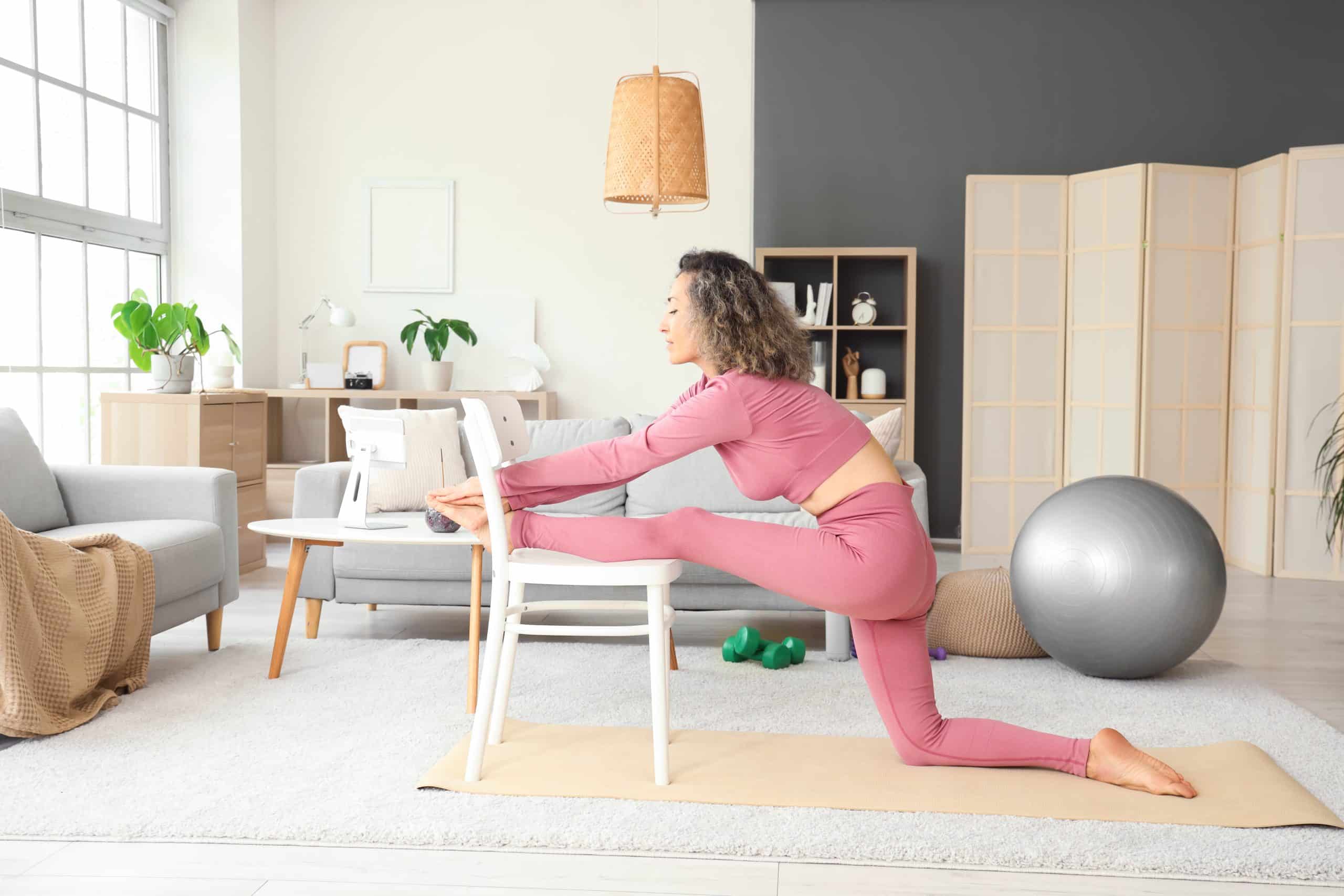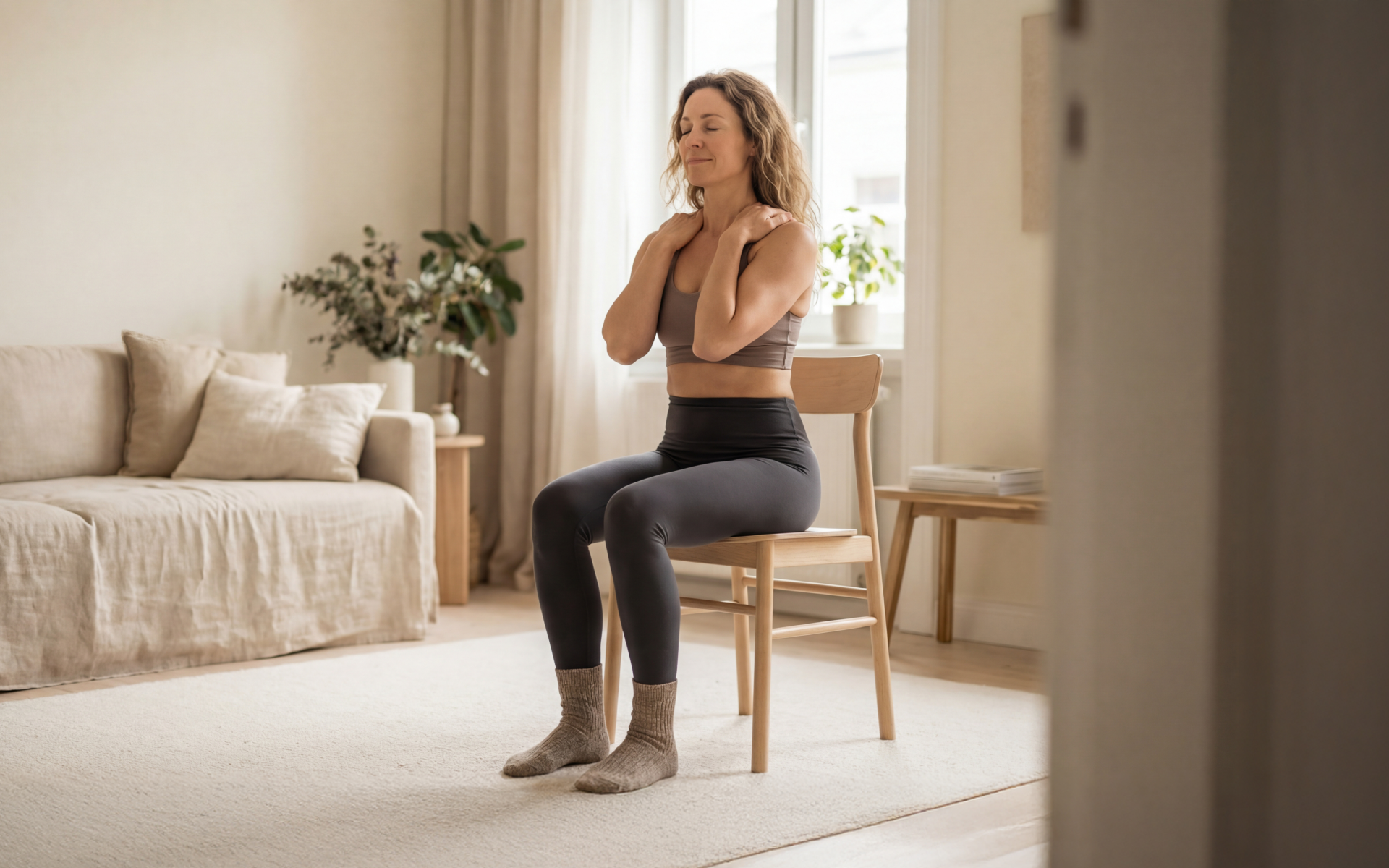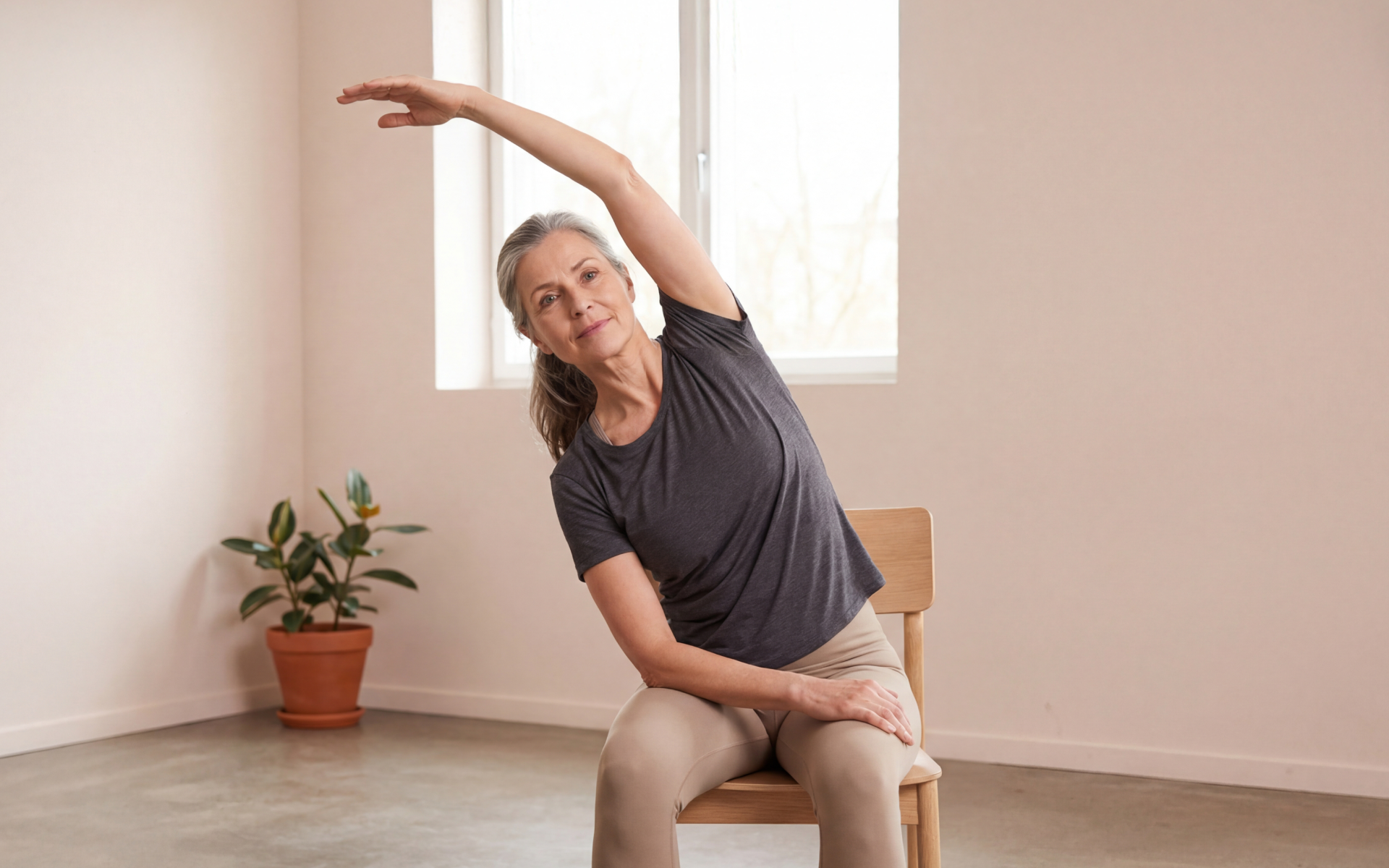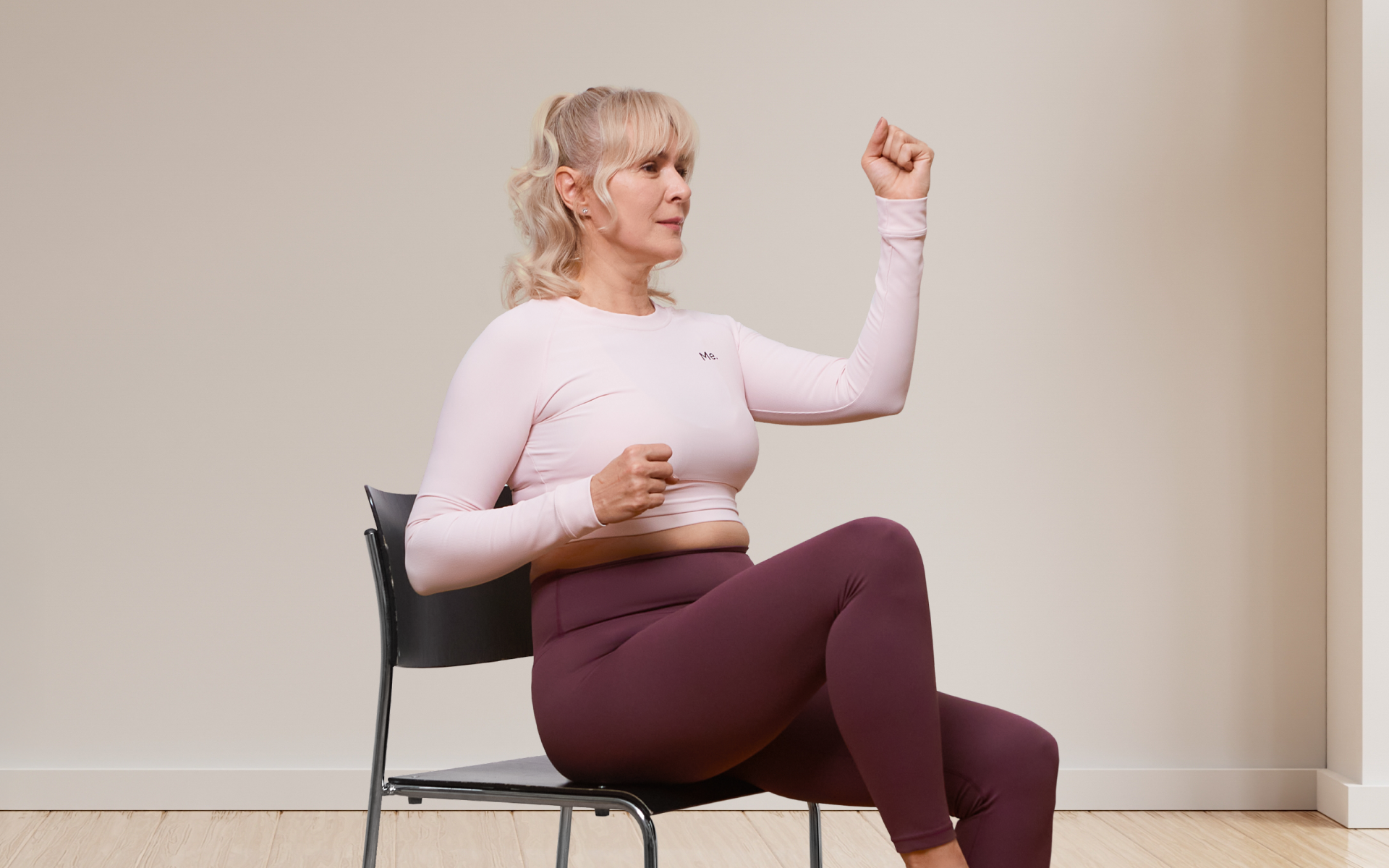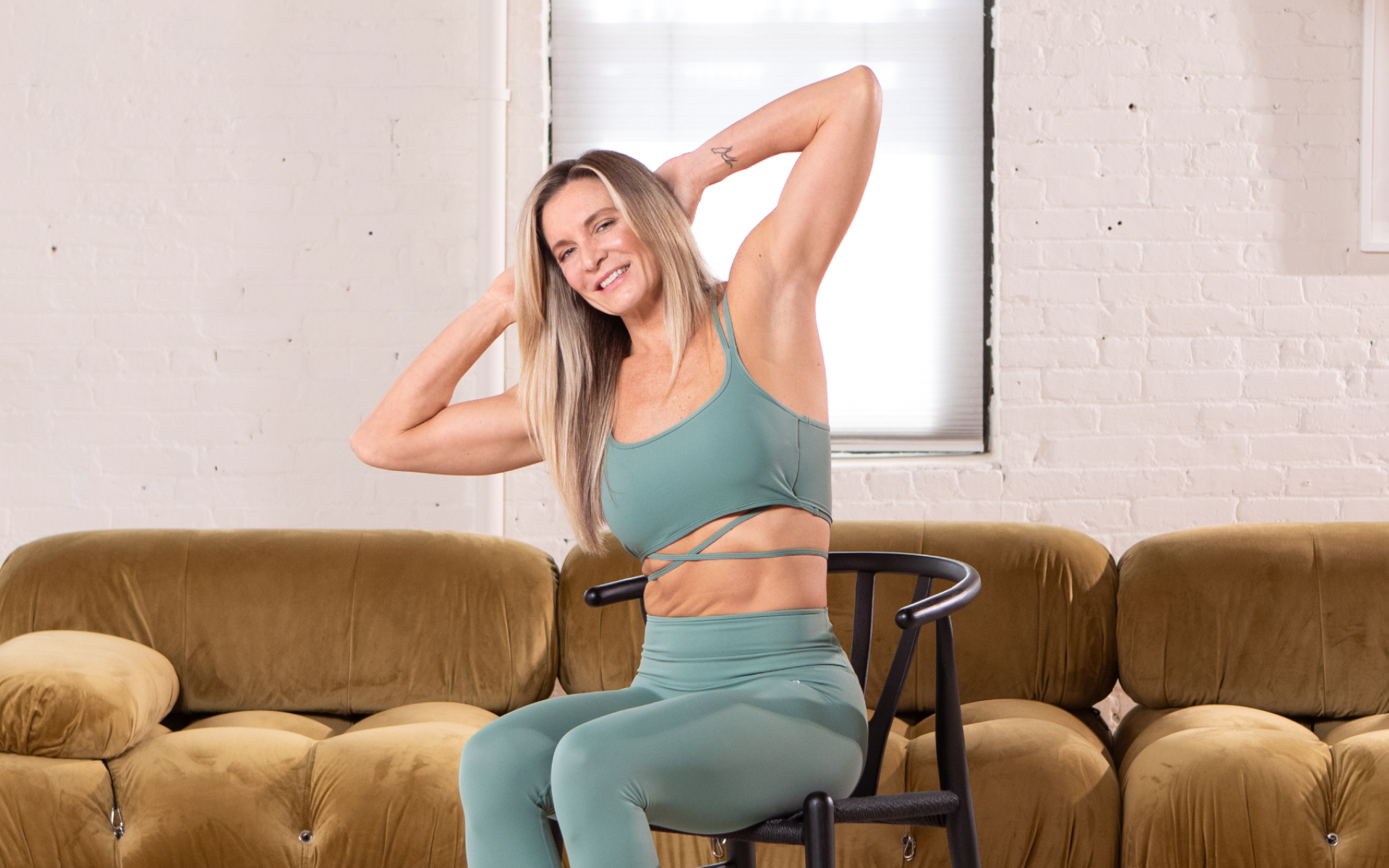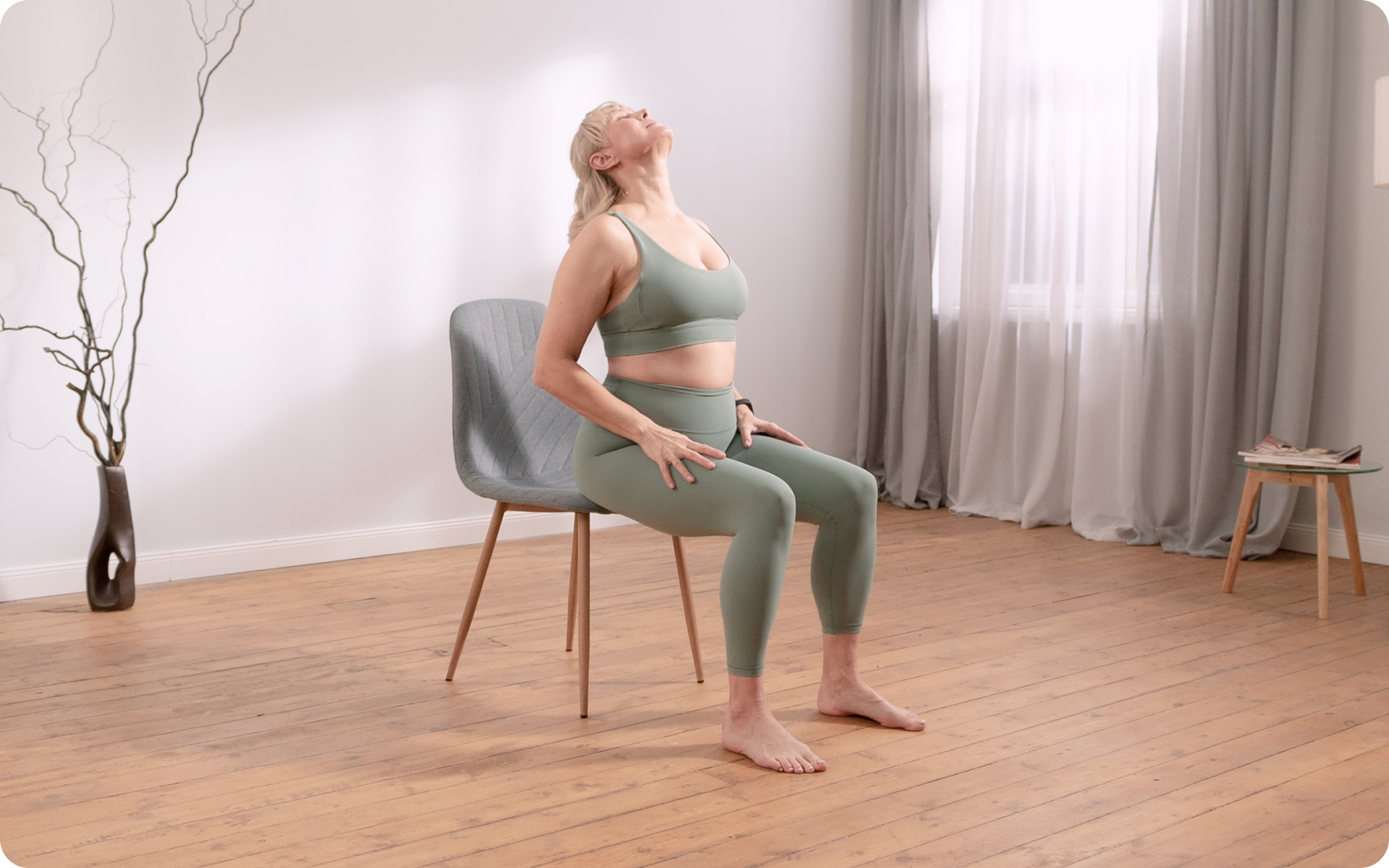Rest and recovery are important aspects of any exercise routine. It allows our bodies time to repair and rebuild, making us stronger and more resilient for our next workout (1).
Not resting and recovering properly can lead to fatigue, injury, and burnout (2).
However, rest days don’t have to mean completely stopping all physical activity. In fact, engaging in low-impact exercises can actually aid in recovery by increasing blood flow and promoting muscle relaxation (3).
One great option for active rest days is chair yoga. This modified form of yoga can be done from the comfort of a chair, making it accessible for people of all ages and fitness levels.
Here are 7 chair yoga exercises you can do on your active rest days to help promote recovery and rejuvenate your body.
But first, let’s discuss why chair yoga is beneficial for recovery.
What Is Chair Yoga for Recovery?
Chair yoga for recovery mostly comes from a majority of the exercises of traditional yoga, adapted for exercising while seated in a chair. It involves gentle movements, stretches, and breathing techniques that can be modified to accommodate any physical limitations.
When done on an active rest day (active meaning you are still moving your body, but not engaging in strenuous exercise), chair yoga can help alleviate muscle tension, promote relaxation, and improve mobility. It also has mental benefits such as reduced stress and anxiety, which can be beneficial for both literally and figuratively “recovering” from a tough workout or busy day (4).
Note, recovery is not important just for athletes and those engaging in intense physical activity. Our bodies and minds can benefit from incorporating rest and recovery practices into our daily lives (5).
Most people who are recovering from an injury or illness can also benefit from chair yoga for recovery, as it allows for gentle movement and stretching without putting too much strain on the body.
However, always consult with your doctor or physical therapist before starting any new exercise routine, especially if you are recovering from an injury.

Can Chair Yoga Be Used for Recovery?
Chair yoga can be a great tool for recovery, as it offers low-impact exercises that help promote relaxation and mobility.
Recovery, in the sense of physical activity, refers to the time and practices we engage in between workouts to allow our bodies to heal and rebuild. This can include things like stretching, foam rolling, or low-intensity exercises.
Chair yoga can be a great option for active rest days, as it allows you to still move your body and get some blood flow going, without putting too much strain on your muscles. It also offers gentle stretches that can help prevent muscle soreness and tightness.
In addition, chair yoga incorporates breathing techniques that can promote relaxation and reduce stress levels. This is not only beneficial for mental recovery but also for improving overall physical well-being.
If you’ve mustered up the courage to crush your weight loss goal, let BetterMe take the sting out of this demanding process. Our app will help you restructure your habits, remold your life and crank up your fitness results!
Does Chair Yoga Speed Up Recovery?
Experts believe that incorporating movement on active rest days can actually speed up the recovery process (3). Gentle exercises, like those done in chair yoga, help increase blood flow and circulation to our muscles, which promotes healing and repair.
The benefits of chair yoga for recovery include:
Improved Blood Circulation
One of the primary benefits of chair yoga for recovery is improved blood circulation. When you engage in gentle exercises like chair yoga, your heart pumps more blood throughout your body. This increased circulation delivers essential nutrients and oxygen to your muscles, which aids in the repair and regeneration process (6).
The gentle movements help to flush out toxins that can buildup in muscles after intense workouts, reducing soreness and speeding up overall recovery.
Enhanced Flexibility and Range of Motion
Chair yoga also enhances flexibility and range of motion, which are critical for recovering from injuries (7). By performing stretches and poses while seated, you can gently work on increasing the elasticity of your muscles and joints without putting excessive strain on them. This gradual improvement in flexibility helps prevent stiffness and promotes a smoother recovery.
Over time, you’ll notice an increase in your ability to move freely and comfortably, which can make daily activities easier and less painful.
Reduced Stress and Pain
Another significant benefit is the reduction of stress and pain. Chair yoga incorporates mindful breathing and relaxation techniques, which can lower cortisol levels and alleviate stress (8).
Reducing stress is crucial during the recovery process because high stress can exacerbate pain and slow down healing. Additionally, the gentle stretching and movement can release endorphins, your body’s natural painkillers, providing a sense of relief and comfort.
Improved Mental Clarity and Focus
Recovery isn’t just about the body; it’s also about the mind. Chair yoga can improve mental clarity and focus, which are often overlooked aspects of recovery.
The meditative aspects of yoga help calm the mind, reduce anxiety, and improve concentration. This mental relaxation allows you to better listen to your body and understand its needs, which can lead to more effective and mindful recovery practices (9).
Read more: 7 Chair Yoga Mobility Exercises for Seniors
Low Impact on Joints
One of the great things about chair yoga is that it has a low impact on your joints. Unlike high-intensity exercises that can cause wear and tear, chair yoga provides a safe way to keep moving without risking further injury (10).
This is especially beneficial for individuals recovering from joint-related issues such as arthritis or surgery. The gentle nature of the movements ensures that you’re not adding unnecessary strain, allowing your joints to heal properly.
Accessibility for All Fitness Levels
Chair yoga is incredibly accessible, making it suitable for people of all fitness levels, including those who are new to exercise or have limited mobility. You don’t need to be an experienced yogi to reap the benefits (4).
The exercises can be easily modified to suit individual needs, ensuring that everyone can participate regardless of their physical condition. This inclusivity means that more people can take advantage of the recovery benefits that chair yoga has to offer.
It Boosts Mood and Emotional Well-being
Last but not least, chair yoga can boost your mood and overall emotional well-being.
Engaging in regular physical activity, even something as gentle as chair yoga, stimulates the production of neurotransmitters like serotonin and dopamine, which are associated with happiness and pleasure (11). This can be particularly important during recovery, a time when individuals might feel frustrated or down due to physical limitations.
A better mood can positively influence your perception of pain and enhance your overall recovery experience.
What Yoga Pose Is Best for Recovery?
Many yoga poses can be beneficial for recovery, especially for those that promote gentle movement and relaxation. Some popular chair yoga poses for recovery include:
- Seated Cat/Cow Stretch
- Seated Twist
- Seated Forward Fold
- Shoulder Rolls
- Neck Stretches
- Seated Pigeon Pose
- Seated Tree Pose
Seated Cat/Cow Stretch
The Seated Cat/Cow Stretch effectively mobilizes the spine, promoting flexibility in the back and neck while engaging the core muscles. This pose helps alleviate tension in the back, which can be particularly beneficial after intense workouts that stress these areas. It stretches the spinal extensors and flexors, as well as the abdominals.
Steps:
- Sit upright in a chair with feet flat on the floor.
- Place your hands on your knees.
- Inhale as you arch your back, lifting your chest and looking up (Cow Pose).
- Exhale as you round your spine, tucking your chin and pulling your belly button in (Cat Pose).
- Continue to flow between these two positions for 5-10 breaths.
Seated Twist
The Seated Twist enhances spinal mobility and improves digestion by stimulating the abdominal organs. This pose engages the oblique muscles, promoting greater core stability while relieving tension in the spine and improving overall posture.
Steps:
- Sit upright in a chair with feet hip-width apart.
- Place your right hand on the back of the chair and your left hand on your right knee.
- Inhale and lengthen your spine, then exhale as you gently twist to the right, deepening the stretch with each breath.
- Hold the position for 5-8 breaths, then repeat on the other side.
BetterMe will keep you laser-focused on your weight loss journey! Nutrient-packed meal plans, fat-blasting workouts, galvanizing challenges and much more. Try using the app and see for yourself!
Seated Forward Fold
The Seated Forward Fold targets the hamstrings, calves, and lower back muscles, providing a deep stretch that can alleviate tension in these areas. By allowing the head and neck to relax, this pose can also calm the mind and aid in stress relief.
Steps:
- Sit at the edge of a chair with feet flat on the floor, hip-width apart.
- Inhale, raising your arms overhead.
- As you exhale, hinge forward from your hips, reaching your hands toward the floor or your feet.
- Hold this position for 5-10 breaths, allowing your back to relax into the stretch.
Shoulder Rolls
Shoulder Rolls are a simple yet effective way to relieve tension in the shoulders and upper back. This movement helps to improve circulation in the shoulder muscles while stretching the trapezius and deltoids, making it beneficial for recovery after upper body workouts.
Steps:
- Sit comfortably in a chair with arms relaxed by your sides.
- Inhale as you lift your shoulders towards your ears.
- Exhale and roll your shoulders back and down, creating a circular motion.
- Repeat this movement for 8-10 rolls, then switch to rolling them forward.

Neck Stretches
Neck Stretches target the muscles in the neck, helping to release tension that may result from prolonged sitting or upper body exercises. This pose works to improve range of motion and can alleviate discomfort, fostering overall recovery.
Steps:
- Sit upright in a chair with your shoulders relaxed.
- Slowly tilt your head to the right, bringing your ear towards your shoulder.
- Hold this position for 5-8 breaths, feeling the stretch along the left side of your neck.
- Return to the center and repeat on the left side.
Seated Pigeon Pose
The Seated Pigeon Pose is beneficial for stretching the hip flexors and the glutes, areas often tight after lower body workouts. This pose can improve flexibility and can alleviate persistent tightness and discomfort in these key muscle groups.
Steps:
- Sit tall in a chair with your feet flat on the ground.
- Cross your right ankle over your left knee, creating a figure-four shape.
- Gently press down on the right knee to deepen the stretch while maintaining an elongated spine.
- Hold for 5-10 breaths, then switch sides.
Seated Tree Pose
Seated Tree Pose nurtures balance and strengthens the core while stretching the inner thighs. This pose fosters stability and focus, allowing recovery not just at the muscle level but also in one’s mental state.
Steps:
- Sit upright in a chair, grounding your feet on the floor.
- Place your right foot on your left thigh or keep it resting on the floor with your knee bent.
- Bring your hands to your heart center and focus on your breath.
- Hold this position for 5-8 breaths, then repeat with the left foot.
Read more: Chair Yoga for Muscle Building: Beginners Guide
FAQs
Does Chair Yoga Count As Exercise?
Chair yoga counts as exercise. As per the Merriam-Webster dictionary, exercise is defined as “bodily exertion for the sake of developing and maintaining physical fitness (12).” While chair yoga may not involve the same level of physical exertion as traditional yoga, it can still provide numerous health benefits such as increased flexibility, improved balance, and reduced stress (13).
What is The Most Healing Yoga?
All yoga has the potential to be healing, as it promotes mind-body connection and overall wellness (6). However, some styles of yoga may be more beneficial for specific health concerns or goals. For example, gentle and restorative yoga can aid in recovery from injury or illness, while power or vinyasa yoga can improve strength and cardiovascular health.
Can You Lose Weight Doing Chair Exercises?
You can lose weight doing chair exercises if you maintain a calorie deficit and follow a healthy diet. Chair exercises may not burn as many calories as high-intensity workouts, but they can still contribute to weight loss when combined with a well-rounded fitness routine (14).
Does Chair Pose Reduce Belly Fat?
Chair pose doesn’t specifically target belly fat, but it is a great overall body workout that engages and strengthens the core muscles (15). A combination of regular chair pose practice and a healthy diet can help reduce excess belly fat over time.
The Bottom Line
Incorporating chair yoga into your recovery routine can have numerous benefits for both physical and mental well-being. It is a low-impact, accessible form of exercise that helps improve blood circulation, enhance flexibility, reduce stress and pain, improve mental clarity and focus, protect joints, boost mood and emotional well-being.
Poses such as Seated Cat/Cow Stretch and Seated Tree Pose are some great options to include in your chair yoga practice for recovery. Remember to always listen to your body and modify poses as needed, and consult a healthcare professional before starting any new exercise routine during recovery.
DISCLAIMER:
This article is intended for general informational purposes only and does not serve to address individual circumstances. It is not a substitute for professional advice or help and should not be relied on for making any kind of decision-making. Any action taken as a direct or indirect result of the information in this article is entirely at your own risk and is your sole responsibility.
BetterMe, its content staff, and its medical advisors accept no responsibility for inaccuracies, errors, misstatements, inconsistencies, or omissions and specifically disclaim any liability, loss or risk, personal, professional or otherwise, which may be incurred as a consequence, directly or indirectly, of the use and/or application of any content.
You should always seek the advice of your physician or other qualified health provider with any questions you may have regarding a medical condition or your specific situation. Never disregard professional medical advice or delay seeking it because of BetterMe content. If you suspect or think you may have a medical emergency, call your doctor.
SOURCES:
- Recovery Strategies: The Secret to Maximizing Workouts (2021, acefitness.org)
- Overtraining Syndrome as a Complex Systems Phenomenon (2022, frontiersin.org)
- A Systematic Review on the Effectiveness of Active Recovery Interventions on Athletic Performance of Professional-, Collegiate-, and Competitive-Level Adult Athletes (2019, journals.lww.com)
- How to Do Chair Yoga (2024, webmd.com)
- Why It’s Important to Allow Yourself to Rest (2021, integrishealth.org)
- Exploring the therapeutic effects of yoga and its ability to increase quality of life (2011, ncbi.nlm.nih.gov)
- Effects of yoga on flexibility and balance: a quasi-experimental study (2017, researchgate.net)
- Fifteen Minutes of Chair-Based Yoga Postures or Guided Meditation Performed in the Office Can Elicit a Relaxation Response (2012, ncbi.nlm.nih.gov)
- Neural correlates of mindfulness meditation-related anxiety relief (2013, academic.oup.com)
- Effect of Chair Yoga Therapy on Functional Fitness and Daily Life Activities among Older Female Adults with Knee Osteoarthritis in Taiwan: A Quasi-Experimental Study (2023, ncbi.nlm.nih.gov)
- The Effects of Acute Exercise on Mood, Cognition, Neurophysiology, and Neurochemical Pathways: A Review (2017, ncbi.nlm.nih.gov)
- Exercise Definition & Meaning (n.d., merriam-webster.com)
- The Effectiveness of Chair Yoga in Older Adults: A Literature Review (2023, researchgate.net)
- Weight loss – a healthy approach (2024, betterhealth.vic.gov.au)
- Chair Yoga (2021, journals.lww.com)
